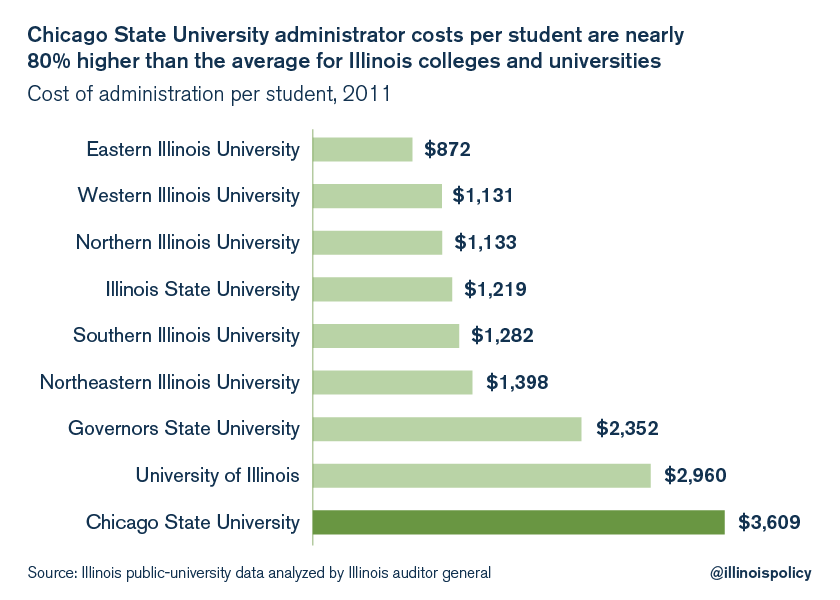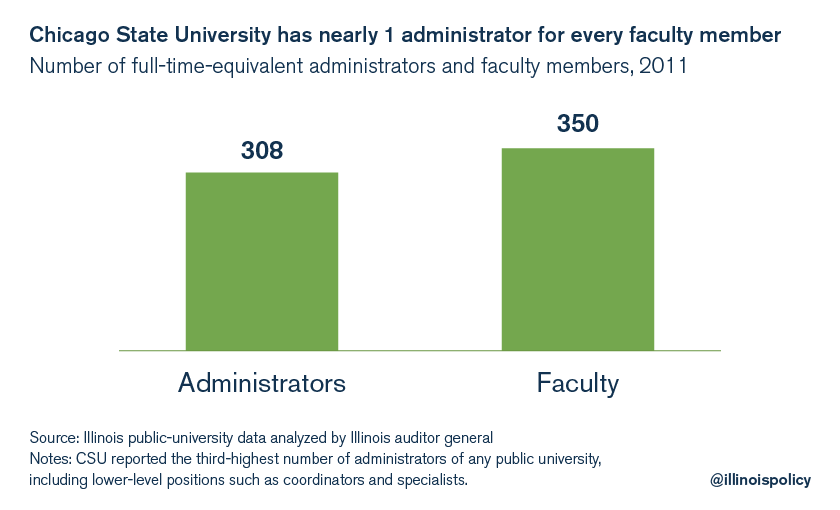Chicago State University students: Blame CSU administration for your troubles
CSU's bloated administration costs more than $3,600 per student, by far the highest of all Illinois' public colleges and universities. By comparison, the average MAP grant at CSU is $2,600 per student.
The 2,100 Chicago State University, or CSU, students who depend on state-funded grants to help pay their tuition have had their grants cut as a result of the state’s budget gridlock. Those students, who have good reason to be upset, have focused their anger on state politicians and the lack of a budget that includes CSU’s $5.5 million in Monetary Award Program, or MAP, grants.
But Illinois’ eight-month budget crisis isn’t the real issue at CSU. Fixing the budget would give students immediate access to their grants, but it would do nothing to attack the core problem that’s pushed tuition beyond their reach – administrative bloat.
At $3,600 per student, CSU has the highest administrator costs in Illinois. That’s nearly 80 percent higher than the average $2,025 per student administrator cost across all Illinois colleges and universities. By comparison, the average MAP grant awarded to CSU students is worth $2,600.
Cutting CSU’s 308-person administrative staff by one-fourth would free more than enough funds to pay for the $5.5 million in MAP grants the university’s students receive. And even with those cuts, CSU would still have the highest administrator-to-student ratio in the state.

CSU’s administrative costs are driven by the large number of administrators it employs. The university has nearly one administrator for every faculty member, according to a 2011 report from the Illinois auditor general. No other public university in Illinois had such a high ratio of administrators to faculty.

Moreover, there are just 17.7 students for every administrator at CSU, a number that’s far smaller than at peer institutions. The University of Illinois has nearly 30 students for every administrator, while the state average is nearly 45 students per administrator.
And though it’s good to have small classes with few students per faculty member (i.e., professors), low ratios shouldn’t be prized when it comes to administrators. When a university has nearly the same number of administrators as faculty members, as CSU does, it’s a recipe for financial distress.
It’s no wonder that CSU’s low-income students have seen tuition rise beyond their reach. The university’s average cost of tuition and fees alone has gone up by more than $5,000 in the last decade.
CSU’s administrative bloat is most extreme when compared with the state’s other universities. However, that does not mean the cost of administration at those universities is any less problematic. The Illinois Senate Democratic Caucus has found that high executive compensation and the size of university bureaucracies are driving up tuition costs in Illinois far above the national average.
University administrators also end up costing the state millions when they retire. The average career (30 years of service or more) retiree in the State Universities’ Retirement System receives a $71,000 starting pension and will take in over $2 million in total pension benefits over the course of retirement. In part due to rising costs, the state already appropriates more to college- and university-worker pensions than it does to university operations.
As Illinois education costs continue to increase uncontrollably and state budget pressures worsen, MAP grants are not the solution to increasing access for low-income students. The best way to make college affordable is to enact administrative and pension reform.
Rather than just blame lawmakers, students at CSU and across the state should direct their frustrations at university leadership, demanding financial reforms and accompanying tuition freezes.
